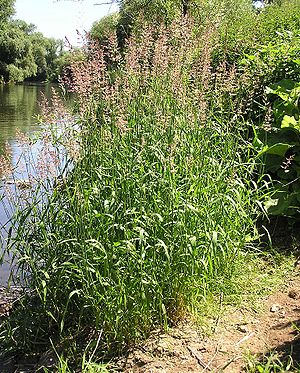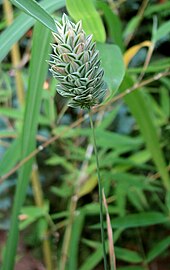Glossy grass
| Glossy grass | ||||||||||||
|---|---|---|---|---|---|---|---|---|---|---|---|---|

Reed grass ( Phalaris arundinacea ) |
||||||||||||
| Systematics | ||||||||||||
|
||||||||||||
| Scientific name | ||||||||||||
| Phalaris | ||||||||||||
| L. |
The glossy grasses ( Phalaris ) are a genus within the sweet grass family (Poaceae).
description
The genus contains annual as well as perennial herbaceous plants . There are clump -forming species as well as lawn-forming species through rhizomes . The height of the grass also varies considerably (up to 40 cm for Phalaris canariensis , up to 2.5 m for Phalaris arundinacea ).
The simple leaves are linear, flat and usually have a well-developed, membranous, non-fringed ligule .
The spikelets are in panicles , either as a whole, so that the panicle resembles an egg-shaped spike (panicle grass), or partially compressed. The laterally clearly flattened spikelets are mostly three-flowered, the two lower flowers are sterile and reduced to lemmas , the uppermost is fertile . The two bald glumes have three distinct green nerves, are boat-shaped and hollow, often keeled or winged along the midrib. They are about as long as the spikelet itself, which means that they exactly enclose the flower. In terms of shape, they can be quite different.
Location requirements
Most species prefer perennial, moist locations along rivers or in swampy places. The invasive species grow as arable weeds or in disturbed areas such as roadsides, on fallow land or on rubble sites.


Systematics and distribution
The genus Phalaris was established by Carl von Linné . The scientific generic name Phalaris is derived from the Greek phalàros for shiny.
The cane grass ( Phalaris arundinacea ) is distributed around the circumference . The other species come mainly from the Mediterranean and the warm-temperate areas of South America . However, some of these species have been widely displaced, so that gloss grass species can be found on all continents.
The genus Phalaris contains 15 to 22 species, depending on the opinion:
- Phalaris amethystina Trin. : It isnativeto central to southern Chile and the Juan Fernández Islands .
- Phalaris angusta Nees ex Trin. : It is distributed from the southern United States to northern Mexico and South America.
- Phalaris aquatica L. (Syn .: Phalaris elongata Braun-Blanq. ): It iswidespreadin Macaronesia and from the Mediterranean to the Caucasus and is a neophyte in Australasia and the New World.
- Reed grass ( Phalaris arundinacea L .; Syn .: Typhoides arundinacea (L.) Moench ) - A reed-like, tall grass that grows cosmopolitan on nutrient-rich river banks. It contains dimethyltryptamine , a hallucinogen.
- Short-flowered glossy grass ( Phalaris brachystachys Link ): The range extends from Macaronesia across the Mediterranean to Iran .
- Phalaris californica Hook. & Arn. : The home is Oregon and California .
- Canary grass or genuine glossy grass ( Phalaris canariensis L. ): It is distributed from the Canary Islands , the Azores and Tunisia through Europe to Turkey and the Caucasus. Also with white-green striped, egg-shaped panicles; is cultivated as an ornamental plant and for the production of bird seed. The original home is likely to be the Canaries and Morocco.
- Phalaris caroliniana Walter : The home is the USA, northern Mexico and Guadeloupe .
- Perennial glossy grass ( Phalaris coerulescens Desf. ): The home is Macaronesia and the Mediterranean.
- Phalaris × daviesii S. T. Blake : This is a hybrid of Phalaris aquatica × Phalaris minor .
- Phalaris lemmonii Vasey : It is only found in California.
- Phalaris lindigii Baldini : The home is Colombia and Ecuador .
- Phalaris maderensis (Menezes) Menezes : It is endemic to Madeira .
- Phalaris minor Retz. : The home is Macaronesia and the Mediterranean area to Eritrea and the Himalayas .
- Strange glossy grass ( Phalaris paradoxa L. ): The distribution area extends from Macaronesia and the Mediterranean to Pakistan .
- Phalaris peruviana H.Scholz & Gutte : The home is Colombia and Peru .
- Phalaris platensis Henrard ex Wacht. : It is distributed from southern Brazil and Uruguay to northeastern Argentina .
- Phalaris truncata cast. ex Bertol. : It is common in the Mediterranean.
Sources and further information
literature
- Werner Rothmaler : Excursion flora for the areas of the GDR and the FRG. Volume 2: Vascular Plants, 14th Edition. People and knowledge, Berlin 1988, ISBN 3-06-012539-2 .
- Thomas Gaskell Tutin : Phalaris L. , pages 244-245. In: Thomas Gaskell Tutin (Ed.): Flora Europaea. Volume 5, Cambridge University Press 1980, ISBN 0-521-20108-X .
Individual evidence
- ^ Phalaris in the Germplasm Resources Information Network (GRIN), USDA , ARS , National Genetic Resources Program. National Germplasm Resources Laboratory, Beltsville, Maryland.
- ↑ a b c d e f g h i j k l m n o p q Rafaël Govaerts (Ed.): Phalaris. In: World Checklist of Selected Plant Families (WCSP) - The Board of Trustees of the Royal Botanic Gardens, Kew . Retrieved November 5, 2016.
- ↑ a b c d e Walter Erhardt , Erich Götz, Nils Bödeker, Siegmund Seybold: The great pikeperch. Encyclopedia of Plant Names. Volume 2. Types and varieties. Eugen Ulmer, Stuttgart (Hohenheim) 2008, ISBN 978-3-8001-5406-7 .
Web links
- Zhen-lan Wu, Sylvia M. Phillips: Phalaris , pp. 335-336 - online with the same text as the printed work , In: Wu Zheng-yi, Peter H. Raven, Deyuan Hong (ed.): Flora of China. Volume 22: Poaceae , Science Press and Missouri Botanical Garden Press, Beijing and St. Louis 2006, ISBN 1-930723-50-4 .
- The grass genera of the world - Phalaris
- Jepson Manual - Phalaris
